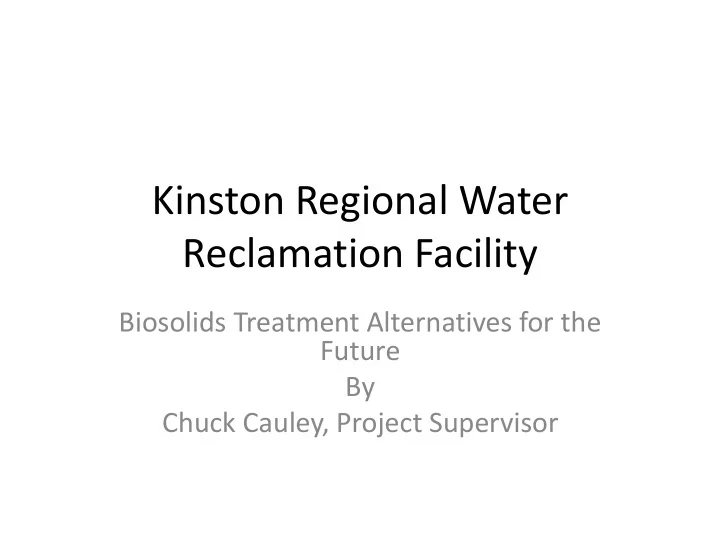

Kinston Regional Water Reclamation Facility Biosolids Treatment Alternatives for the Future By Chuck Cauley, Project Supervisor
Solids Handling History • Prior to 1994, solids were either sent to a sludge holding lagoon or were placed on drying beds and landfilled. • From 1994 to 2002, solids were digested to meet Class B standards and was land applied as a liquid. • In 2002 to present, Two Ashbrook Filter Presses were installed and caked solids were continued to be land applied.
Why the Desire to Change? • Under current conditions we have about 3 months storage capacity. • Due to other obligations and weather conditions, moving material is proving to be more difficult. • Animal waste is competing for land use. • Disposal cost continue to increase. • Dried solids mostly eliminate these issues depending on end use of product.
Problems with Class B Materials • Mother Nature • Contractor Issues • Land Use Restrictions • Limited Participation from Farmers • Can Only be Land Applied or Land Filled • Cost of Disposal
More Problems with Class B Materials • The National Research Commission (NRC) is an independent research group that worked with the USEPA in developing the Federal 503 regulations. • Based on scientific data of the time, the NRC concluded that sludge treated to meet Class B standards was safe and not an issue to public health as long as their protocols and recommendations were met.
Class B Continued • The NRC did not complete their study as it left out direct exposure effects to workers handling this materials. • New concerns to public health as a result of new and emerging antibiotic bacteria have been steadily increasing over the last ten years. • To date, there is no scientifically documented evidence to support public health concerns associated with Class B materials.
Class B Continued • However, due to the lack of knowledge and outdated operational criteria, allows room for doubt and concerns for the safety of public health. • Since the rise of the “Super Bug”, more concerns have been raised associated with runoff from land applied areas for water quality of downstream users.
Why Class A? • More Options for Disposal • Less Scrutiny by Regulators and the General Public. • More Accepted by Public • More uses for Dried Biosolids • Potential for cost reduction for Biosolids Treatment. • Not at the Mercy of Mother Nature and the Contractors. • Mitigates public concerns of harmful bacteria.
Aerated Static Piled Composting
Composting • Composting is a means to naturally breakdown the organics in solids to produce a stable and safe means for recycling biosolids for beneficial use. • Composting is an environmentally friendly way to recycle nutrients. • The are different methods of composting but the Aerated Static Pile was the most used in my surveys. • For the exception of one case, composting has not been a very successful means of disposal.
Raw Materials At this site, wood chips are stored in piled rows on the left side of the photo and leafy materials are on the right. Approximately two acres were set aside for raw material storage. This facility used a mix ratio of 1 part biosolids, 1 part chip wood, and, two parts of leaves.
Compost Curing Piles Note the drainage of water from Curing pile more under the the pile. shelter
Temperature Monitoring Temps @ 140 degree F.
Equipment Blender used to mix raw material Screener to separate the larger and biosolids particles
Finished Compost
Chip Wood Storage
Mixing Area
Curing Area
Screenings
Finished Product
Storm/Wastewater Retention and Weighing Station Wastewater Retention Storm water Retention
Composting Summary • Equipment • Labor • Fuel Cost for Loaders • Land • Virtually no electrical cost • Low demand for final product
Thermal Dryers Drum Dryers Belt Dryers
Thermal Dryers Rotating Disc Batch Dryers
Thermal Drying • Thermal Drying is another means to drive off moisture and kill off pathogenic bacteria. • This method is widely accepted by general public. • Low odor emissions. • High demand for final product.
Continued Thermal Drying • All units produced a great product. • There were no issues with disposal. • Depending on the unit, they had high maintenance issues, more some than others. • There are fire issues with some systems but not all. • Fuel consumption was a major factor in making our choice.
Thermal Drying Concerns Drum Dryers • Very high maintenance systems • Fire prevention / extinguisher measures required. • Dusty conditions • Equipment repairs • Personnel issues • High fuel consumption • High heat requirements
Maintenance Issues
Maintenance Fire Suppression Red Hoses for Nitrogen Gas
Finished Hopper
Maintenance SCADA System Duel Gas Feed System
Thermally Dried Solids Compared to Composting • Compost – 29 pounds / cubic foot • Thermal – 44 pounds / cubic foot • Compost - $288 / Dry Ton to produce • Thermal - $189 / Dry Ton to produce • Compost Sales - $15,000 / Year • Thermal Sales - $24,500 / Year
Summary • Based of our research, we decided that thermal drying was our best option. • We decided that a batch fed process would be a better fit for our operation. • It has low heat/low fuel consumption • Very flexible to our needs • Produces a great product.
What Led to Kinston’s Decision • We asked for proposals /presentations from various companies • We ran pilot studies on the top two proposals • Drum dryer and a belt dryer • Performed cost analysis for each unit and decided on the belt dryer from SUEZ • 10 dry ton unit (Plant’s Capacity) • Current Production is approximately 5 dry tons per day • This allows for outside users
Brief Cost Analysis Report Capital Cost: $2.9 Million Operating Cost: $90,600 Beginning Revenue: $12,000 Current Disposal Cost: $175,000 Annual Disposal Savings: $90,600
Dryer Componets
Belt Dryer
Boiler and Other Pics
Questions?
Recommend
More recommend